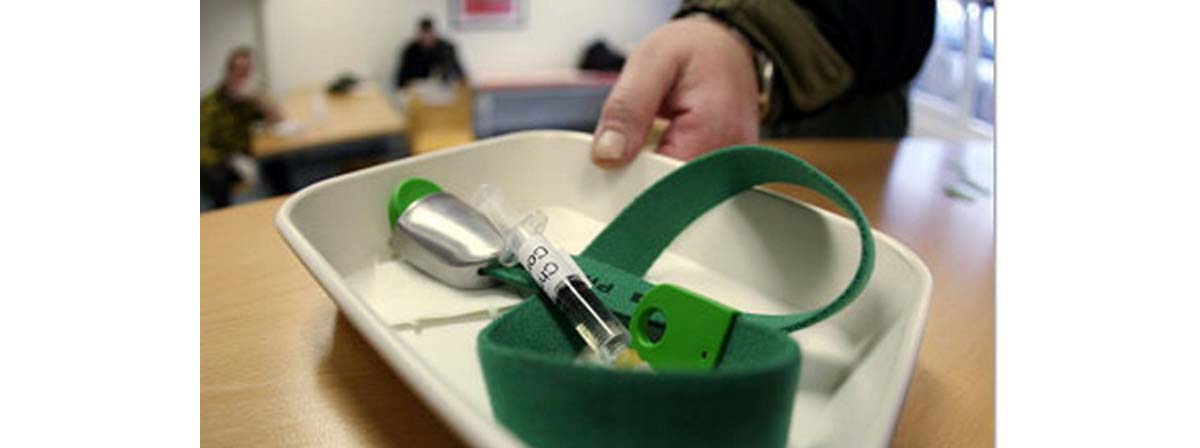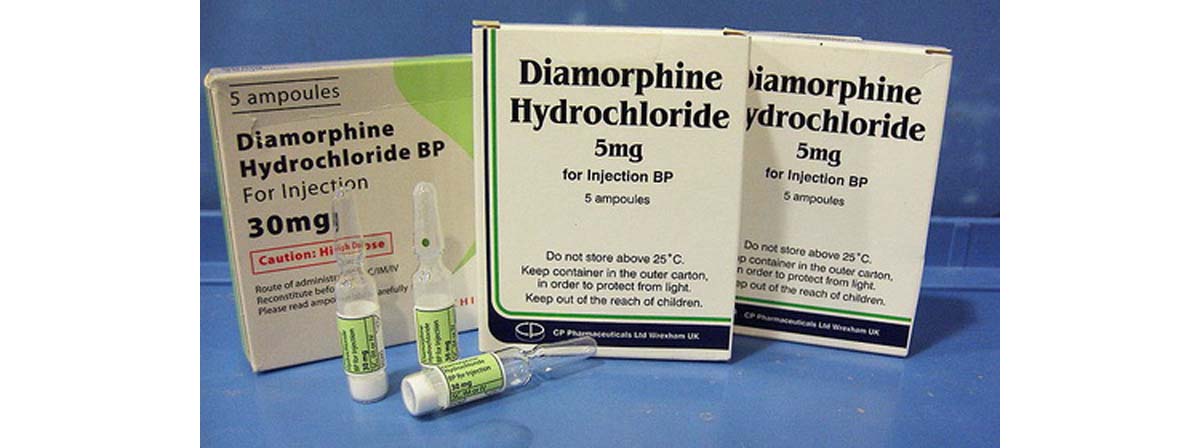Medicinal properties of opioids, the alkaloids derived from the opium poppy plant, are well known from ancient history. Various derivatives of natural morphine are know at present time. Despite different properties, chemically they are very similar.

One of the most powerful painkillers in medical use is diamorphine. Diamorphine is also known as morphine diacetate or heroin. This is a derivative of natural alkaloid morphine.
Heroin was synthesized for the first time by acetylation of morphine in 1874, by R.C. Alder Wright who worked at St. Mary’s Hospital Medical School in London. The discovery didn’t attract much attention. Felix Hoffmann from German company Aktiengesellschaft Farbenfabriken (now known as Bayer) has synthesized the drug again 23 years later.
From 1898 to 1910 the drug was advertised by Bayer under the name Heroin as a non-addictive substitute of morphine and cough medicine. This is still considered as one of the biggest blunders in the company’s history. During the 1920s the legislation was adopted in most countries to ban the drug.
Diamorphine has multiple medical applications
In medicinal purposes diamorphine is used to treat severe pain. The conditions such as heart attack, severe injury and post-surgical pain often require the use of strong analgesic drugs such as diamorphine. The drug is also used for patients suffering from severe pain at terminal stages of some illnesses like cancer.
Diamorphine has essentially the same uses as another opioid analgesic drug, morphine. Diamorphine shows less severe side effects than morphine. Essentially, this is a faster acting form of morphine.
Like other opioids, diamorphine can be used as both analgesic and recreational drug.
Diamorphine is the pro-drug of morphine. This means that it is metabolically converted inside the body into morphine.
Chemically two compounds are very similar. Diamorphine has two additional acetyl groups. These groups get removed in the body with the help of enzymes called esterase.
Diamorphine is more potent than morphine. As a result, smaller doses of diamorphine are needed to achieve the same effect. This is a result of higher solubility of diamorphine in lipids and, consequently, better ability to cross the blood – brain barrier. Most of the physiological targets of these drugs are located in various regions of brain.
Opioid alkaloids bind to the specific proteins in the body called opioid receptors that mediate their effects. There are several types of opioid receptors in the human body. They include µ-opioid receptors, as well as κ- and δ-receptors. Heroin works on µ-opioid receptors only.
Both Negative And Positive Effects Of Opioids Are Directly Linked To Their Mechanism Of Action
Opioid receptors are trans-membrane proteins – they are located inside the cell membrane, with parts of protein exposed to the outside and inside the cell. The position of these proteins on the membrane of nervous cells is critical for their action. Upon binding with diamorphine or other opioids, the receptors cause hyperpolarization of cell membrane. Hyperpolarization prevents the release of brain signalling molecules, neurotransmitters. This results in inhibition of pain transmission in many neuronal pathways.

Diamorphine can easier cross the blood-brain barrier than morphine. In the brain, it gets de-acetylated and form morphine, the active form of drug. Morphine binds to the µ-opioid receptors in the brain. This caused analgesic effect, as well as euphoric and anti-anxiety effects. Diamorphine itself doesn’t bind efficiently to the µ-opioid receptors.
The molecules of morphine are not efficient in crossing the blood-brain barrier. That’s why the effect of morphine is not as pronounced as the effect of heroin.
µ Receptors are also found in the spinal cord and intestinal tract. Due to their action on the intestinal tract, the opioid drugs including diamorphine can cause constipation since they inhibit the peristaltic movements.
Frequent administration of diamorphine leads to the increase of the level of opioid receptors and results in a less effective response to the drug. This may lead to the need to increase the drug dose to achieve the painkilling effect upon prolonged administration.
In the human body, the opioid receptors get activated by natural ligands – so called endogenous opioids. Structurally, endogenous opioids are short peptides: enkepalins, endorphins, dynorphins, endomorphins. Opioid drugs are able to mimic the action of endogenous opioids.
Side effects and negative effects associated with the use of opioid drug
Unfortunately, administration of opioid drugs and heroin in particular is associated with physical dependence (drug addiction). Heroin is a legally prescribed controlled drug in many countries.
Drug addicts often share needles while injecting drugs. The users of heroin are thus exposed to the higher danger of transferring other diseases such as HIV and various forms of hepatitis.
There is also possibility of overdose which may cause the fatal respiratory depression. The drug is frequently used for murders and suicides. Famous recent example is British Doctor Harold Shipman who used diamorphine to kill his numerous elderly victims.
Diamorphin (heroin) has the highest level of dependence and produce the largest physical harm among all commonly used recreational drugs.
Pros and cons of using heroin
Diamorphine is one of the strongest known analgesic drugs and it is invaluable as a painkiller, particularly when the pain is severe and unbearable. This drug, like all other opioids, work on the level of specific receptors that regulate neurotransmission and sensitivity to pain. Unfortunately, most of opioids, and heroin in particular, cause physical addiction which becomes an issue if the drug is administered over long periods of time. Non-addictive alternatives to diamorphine, including the drugs targeting other proteins involved in the transmission of pain, are currently being developed by various pharmaceutical companies.
Despite the therapeutic advantages of diamorphine, its negative side effects are the cause of concern for the practitioner. In the absence of suitable alternative, the drug should be used with caution and only when really needed.
- Inturrisi, C, Schultz, M, Shin, S, Umans, J, Angel, L, Simon, EJ (1983). Evidence from opiate binding studies that heroin acts through its metabolites. Life Sciences 33: 773–6
- Janecka A, Fichna J, Janecki T (2004). Opioid receptors and their ligands. Curr Top Med Chem 4 (1): 1–17
- Pergolizzi, J. et al. (2008) Consensus statement: Opioids and the management of chronic severe pain in the elderly. Pain Practice 8, 287-313
- Sawynok J (1986). The therapeutic use of heroin: a review of the pharmacological literature. Can. J. Physiol. Pharmacol. 64 (1): 1–6
- Smith, H.S. and Elliott, J.A. (2012) Opioid-induced androgen deficiency. Pain Physician 15, ES145-ES156
- Waldhoer M, Bartlett SE, Whistler JL (2004). Opioid receptors. Annu. Rev. Biochem. 73: 953–90
- Photo courtesy of unknown author by Wikimedia Commons : commons.wikimedia.org/wiki/File:Diamorphine_prescription.jpg
- Photo courtesy of Pete Chapman by Wikimedia Commons : commons.wikimedia.org/wiki/File:Diamorphine_ampoules.JPG

